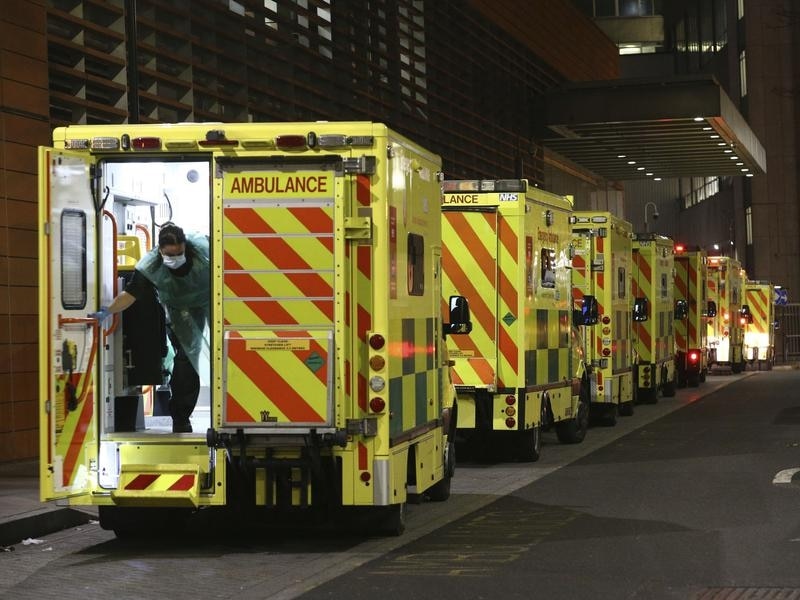A COVID-19 vaccine from Oxford University and AstraZeneca has been approved for use in the UK, paving the way for a rapid rollout, Britain’s Department of Health says.
The jab, which has been described as a “game changer”, was given the green light by the Medicines and Healthcare products Regulatory Agency (MHRA).
The welcome news comes as coronavirus patient numbers in the UK reached their highest levels during the pandemic, with 51,135 further cases in one day and 414 deaths reported on Tuesday.
The UK has ordered 100 million doses of the new vaccine – enough to vaccinate 50 million people.
A Department of Health and Social Care spokesman said on Wednesday: “The Government has today accepted the recommendation from the Medicines and Healthcare products Regulatory Agency (MHRA) to authorise Oxford University/AstraZeneca’s COVID-19 vaccine for use.
“This follows rigorous clinical trials and a thorough analysis of the data by experts at the MHRA, which has concluded that the vaccine has met its strict standards of safety, quality and effectiveness.”
Data published in The Lancet medical journal in early December showed the vaccine was 62 per cent effective in preventing COVID-19 among a group of 4,440 people given two standard doses of the vaccine when compared with 4,455 people given a placebo drug.
Of 1,367 people given a half first dose of the vaccine followed by a full second dose, there was 90 per cent protection against COVID-19 when compared with a control group of 1,374 people.
The overall Lancet data, which was peer-reviewed, set out full results from clinical trials of more than 20,000 people.
Among the people given the placebo drug, 10 were admitted to hospital with coronavirus, including two with severe COVID which resulted in one death.
But among those receiving the vaccine, there were no hospital admissions or severe cases.
The half dose followed by a full dose regime came about as a result of an accidental dosing error.
In an interview with the Sunday Times, AstraZeneca chief executive Pascal Soriot suggested that further data submitted to the regulator showed the vaccine could match the 95 per cent efficacy achieved by the Pfizer/BioNTech and Moderna vaccines.
“We think we have figured out the winning formula and how to get efficacy that, after two doses, is up there with everybody else,” he said.
On Monday, Calum Semple, professor of outbreak medicine at the University of Liverpool and a member of the Scientific Advisory Group for Emergencies (Sage), described the vaccine as a “game changer” but said it would take until summer to vaccinate enough people for herd immunity – when the virus struggles to circulate.
Ambulance queues at UK hospitals
Pictured emerged on Tuesday of emergency vehicles lined up outside the Royal London Hospital in Whitechapel and Queen’s Hospital in Romford, both in east London, as NHS Providers’ deputy chief executive Saffron Cordery warned pressure on the NHS was “rising at an unsustainable rate”.
A statement released by the Barking, Havering and Redbridge University Hospitals NHS Trust, which runs Queen’s Hospital, urged people to only contact ambulance services in the case of real emergencies.
“Along with the rest of the NHS, we are under considerable pressure as we look after a rising number of COVID-19 patients, some of whom are being cared for safely in ambulances before entering Queen’s Hospital,” it said.
The Barts Health NHS Trust, which is responsible for Royal London Hospital, said in a statement it had opened an extra coronavirus ward on Sunday.
“We are treating very high numbers of patients with COVID-19 across our hospitals, and in line with our winter escalation plan we have moved into a ‘very high pressure’ phase and taking steps to keep our patients safe,” it added in its statement on Tuesday.
Palliative care doctor Rachel Clarke tweeted a photo, taken by registrar Punith Kempegowda, with the caption noting there was a “sick patient inside every one” of the vehicles.
“This is the reality of Covid – right here, right now. Hospitals are at breaking point,” Dr Clarke said.
Health Secretary Matt Hancock is expected to tell the Commons on Wednesday more areas in England will be placed under the country’s toughest coronavirus restrictions.
Prime Minister Boris Johnson chaired a meeting of the Government’s COVID-19 Operations committee on Tuesday evening, when changes to the tier system were discussed.
Areas that may be moved from Tier 3 to Tier 4 due to increasing case rates include parts of the East Midlands, such as Northamptonshire and Leicestershire, as well as all areas of the West Midlands metropolitan county.
Hartlepool in north-east England, along with a handful of areas in Lancashire – Blackburn with Darwen, Burnley, Pendle and Ribble Valley – could also be upgraded from Tier 3 to 4.
The Times reported ministers are also considering imposing the country’s toughest measures on parts of the south-west and Cumbria.
People in Australia must stay at least 1.5 metres away from others. Check your jurisdiction’s restrictions on gathering limits. If you are experiencing cold or flu symptoms, stay home and arrange a test by calling your doctor or contact the Coronavirus Health Information Hotline on 1800 020 080. News and information is available in 63 languages at sbs.com.au/coronavirus
Please check the relevant guidelines for your state or territory: NSW, Victoria, Queensland, Western Australia, South Australia, Northern Territory, ACT, Tasmania







